*This post may contain affiliate links. Read more »
In Turkish, Lahana means cabbage, and sarma means rolled or wrapped. You are about to learn with step-by-step guidance to make the most gorgeous, flavorful stuffed cabbage leaf wraps that are 100% vegan and gluten-free. In this blog post, we’re gonna save you from having lahana sarmasi that fall apart on you, or end up with uncooked filling inside that would make a gaggle of ponies cry in despair. Made following my method, these make a great introduction to vegetarian Turkish cuisine!
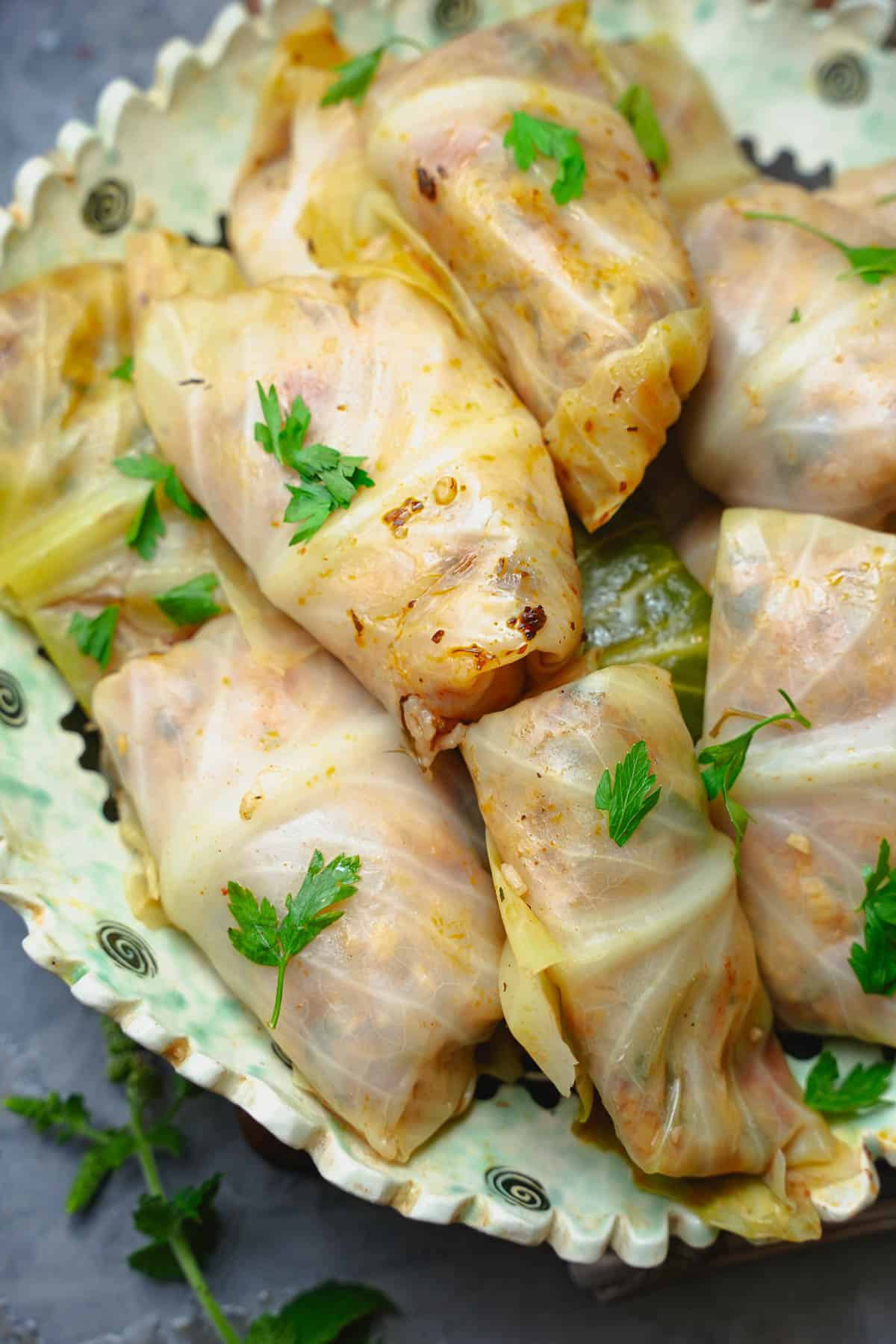

Enter your email & I'll send it to your inbox. Plus, get great new recipes from me every week!
By submitting this form, you consent to receive emails from Cinnamon Snail.
Like Turkish Şakşuka, Zeytinyağlı Kereviz Yemeği, and Acılı Ezme, these tender cabbage rolls don’t require fancy equipment, hard-to-find ingredients, or years of experience. In fact, one of the things I love about this recipe, is that the filling doesn’t even need to be pre-cooked beforehand, and these are great served hot or at room temperature, making them awesome for potlucks or gatherings.
Gather up your cutest apron, prepare your cabbage leaves, and get your home smelling like heavenly Lahana Sarma!
Jump to:
🥰Why you'll adore these Turkish cabbage rolls
✊Vegan AF: Some people fill these with ground meat, but here, where I share TONS of vegan Turkish recipes, they are without the cholesterol and violence towards animals.
🌿Nourishing comfort food: Lahana Sarma is a nourishing symphony of simple and healthful components. There is no soy, wheat, dairy, or gluten, and they are full of fiber and all the good stuff!
🏁Fast to Make, 👴 Lasts Good & Long Too! With an uncomplicated ingredient list and straightforward instructions, you’ll find yourself savoring these delectable cabbage rolls.
✅Tested and Approved Worldwide: Like all of the vegan recipes on my blog, this one's been made and loved by a team of over 500 recipe testers!


Transform Your cooking with Turkish Vegan Magic
This 6-day program is 100% FREE. Get Ready to Master Turkish Vegan Cuisine!
🥬 Ingredients for lahana sarması

Tatli Biber Salcasi
Originating from Turkey, Tatli Biber Salcasi, or sweet red pepper paste, brings a burst of vibrant flavor to lahana sarması. For a substitute, consider using roasted red pepper puree, or tomato paste. If you want to make the cabbage rolls a bit spicier, you can use aci biber salcasi (Turkish hot pepper paste) instead.
Dried Mint
I’m lucky that mint grows like crazy in my yard, and my wife always has bunches of it drying in bundles around our home. That way, we have a steady supply of fresh and dried mint all year round. If you don’t have dried mint, you can use minced fresh mint leaves, or another herb, such as cilantro, in its place for a different, but still yummy flavor.
Rice
I use either short grain white rice or basmati rice to fill these. You can use brown rice instead, but you may need to increase the water in the cooking liquid and the cooking time a little, as brown rice takes a bit longer to cook. Bulgur is a great option to use in the filling too, and is in many traditional recipes for lahana sarma. Quinoa, or farro can also be great substitutes if you hate rice with all your heart and soul.
Green Cabbage
Green cabbage, or “lahana” in Turkish is made tender and good for wrapping the filling with a quick blanching. Rich in fiber and vitamins, cabbage provides both texture and health benefits to the dish. You can also make these with collard greens as the wrappers instead. Just do a much shorter blanching, under 30 seconds, as collards are a bit more tender to begin with than cabbage.
*See the recipe card at the bottom of the page for exact quantities, nutritional information, and detailed cooking directions.
🤯 Other ways to make Turkish cabbage rolls vegetarian
✌️Mercimek Lahana Sarmasi
Replace the rice with cooked brown lentils and stir in chopped spinach and lemon zest, creating a hearty filling that’s high in plant-based protein. You could even use a similar mix to what I use for making Mercimek Kofte.
🔥Spicy Lahana Dolmasi:
Add a kick by incorporating a spoonful of shatta sauce into the filling.
📖 How to make this Lahana Sarmasi recipe
Make these cabbage rolls perfectly on your first shot following these step-by-step instructions with important tips. Or you can follow along with the easy-to-print recipe card towards the bottom of this page.
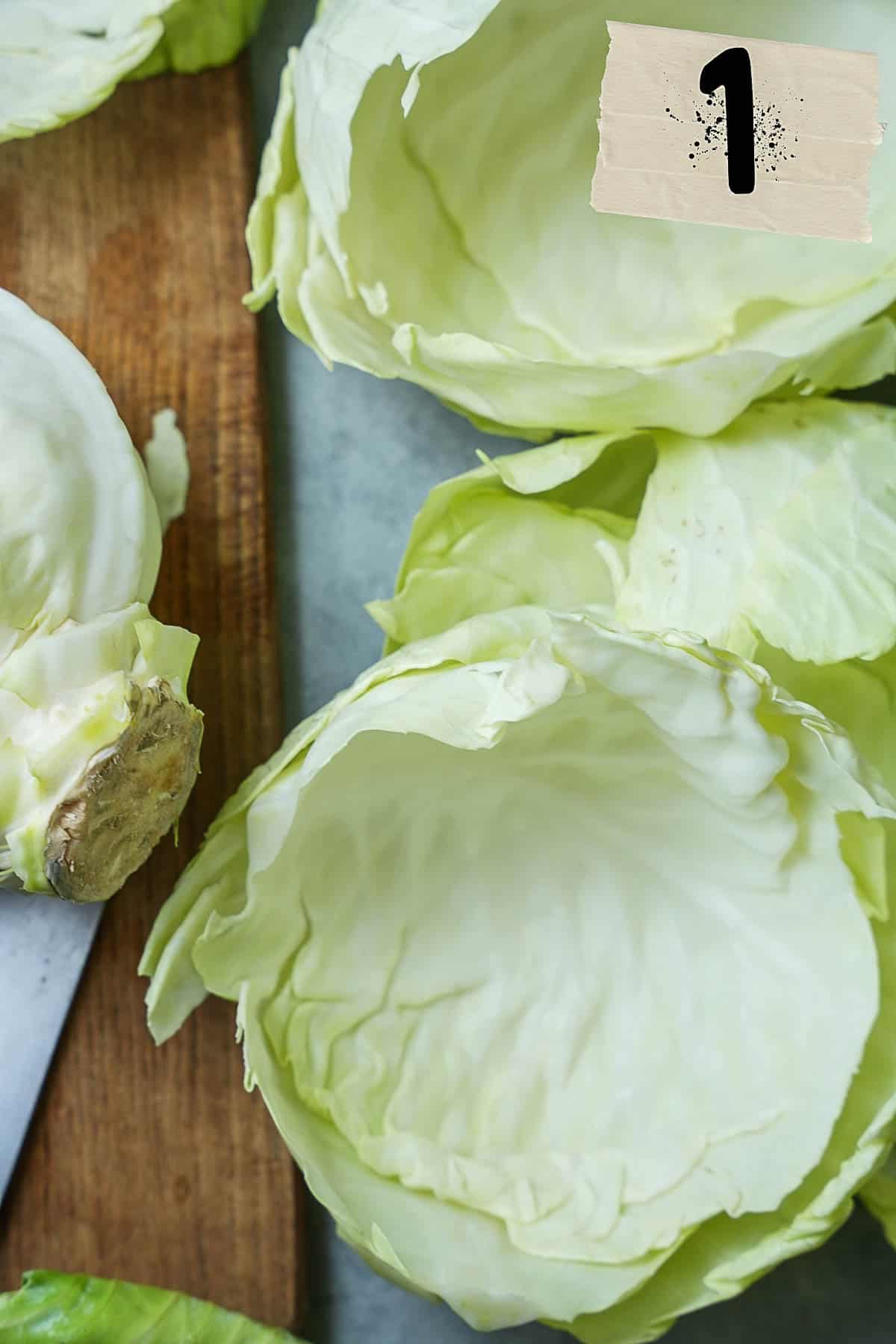
Step one
Give your cabbage head a gentle once-over, discarding any external leaves if they don’t look gorgeous. Carefully peel off all of the leaves, ensuring they remain intact. A paring knife is handy to remove them from the base. Save any small or torn leaves to line the bottom of the pot with later.

Step two
Bring a pot of water to a rolling boil and drop in the cabbage leaves. Blanch for a few minutes until they’re just tender. Once they’ve softened, scoop them out and set them aside to cool down a bit.
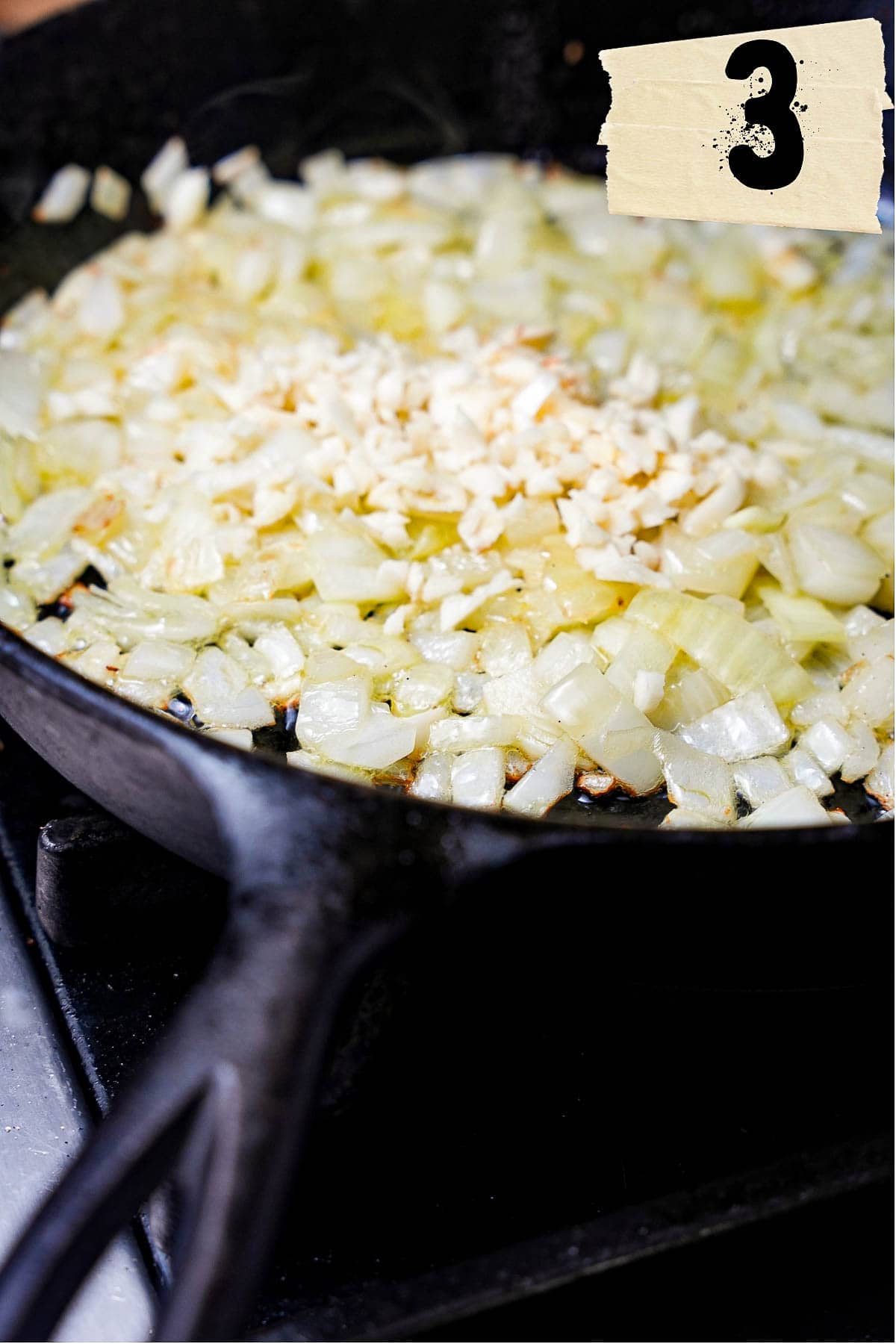
Step 3
Warm olive oil over medium heat for 60 seconds in a Dutch oven or skillet. When the oil is hot, add in the diced onion and sauté for around 4-5 minutes until lightly golden. Then stir in the minced garlic, letting its aroma mingle with the onions for about a minute.

Step 4
Stir in the tatli biber salcasi (or tomato paste if you don’t have any Turkish style pepper paste) and sprinkle sumac into the onions and garlic, letting them sauté together for a couple more minutes.
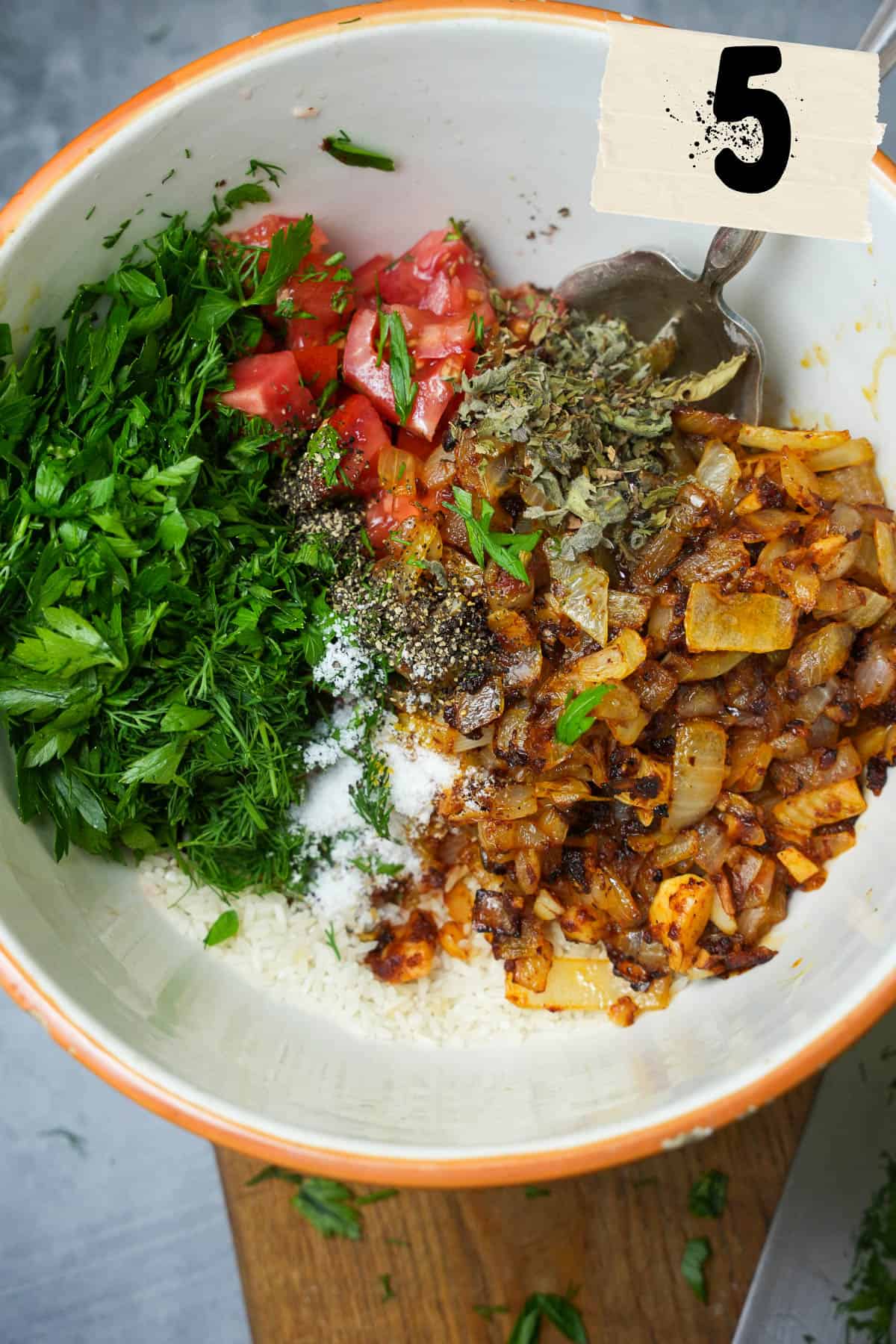
Step 5
Mix the contents of the pan in a medium bowl along with diced tomatoes, chopped parsley, fresh dill, dried mint, black pepper, sweet paprika, salt, and uncooked rice. If you want to add some heat, you can stir in a spoonful of shatta sauce.
➡️ You can use just about any rice, but I prefer a quick cooking rice for these, like short-grain white rice, jasmine, or basmati. Brown rice will take longer and may need a little extra water added as it cooks.
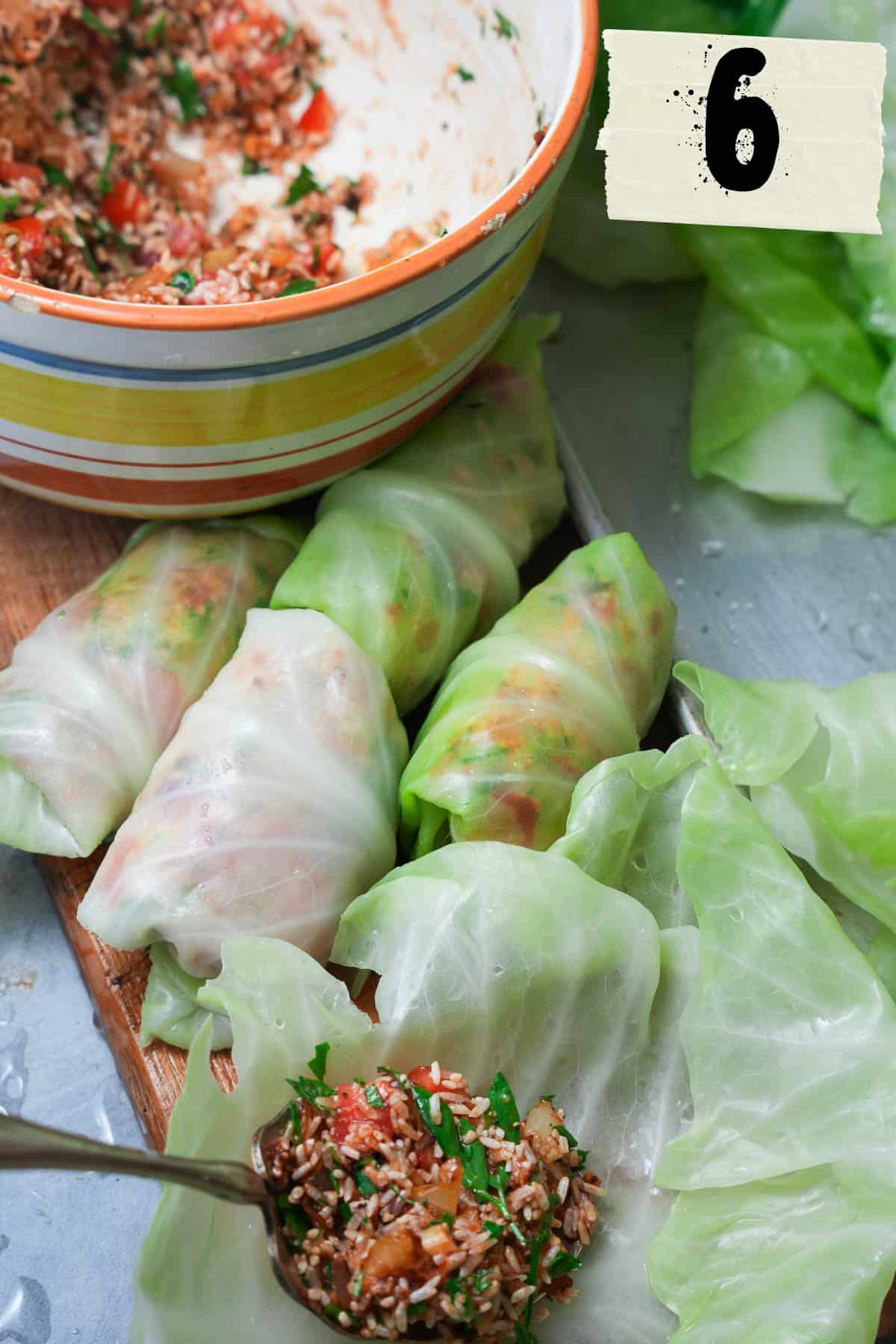
Step 6
Lay a blanched cabbage leaf down, rib side facing down, on a clean work surface or cutting board. Spoon a hearty helping of the filling into the centre and roll it up, tucking in the sides like a snug little burrito. Repeat this process until you’ve used up all your leaves or filling. Every cabbage is a little different, so the yield will not be 100% predictable.
➡️ Save any extra, small, or torn leaves to line the bottom of the pot with.
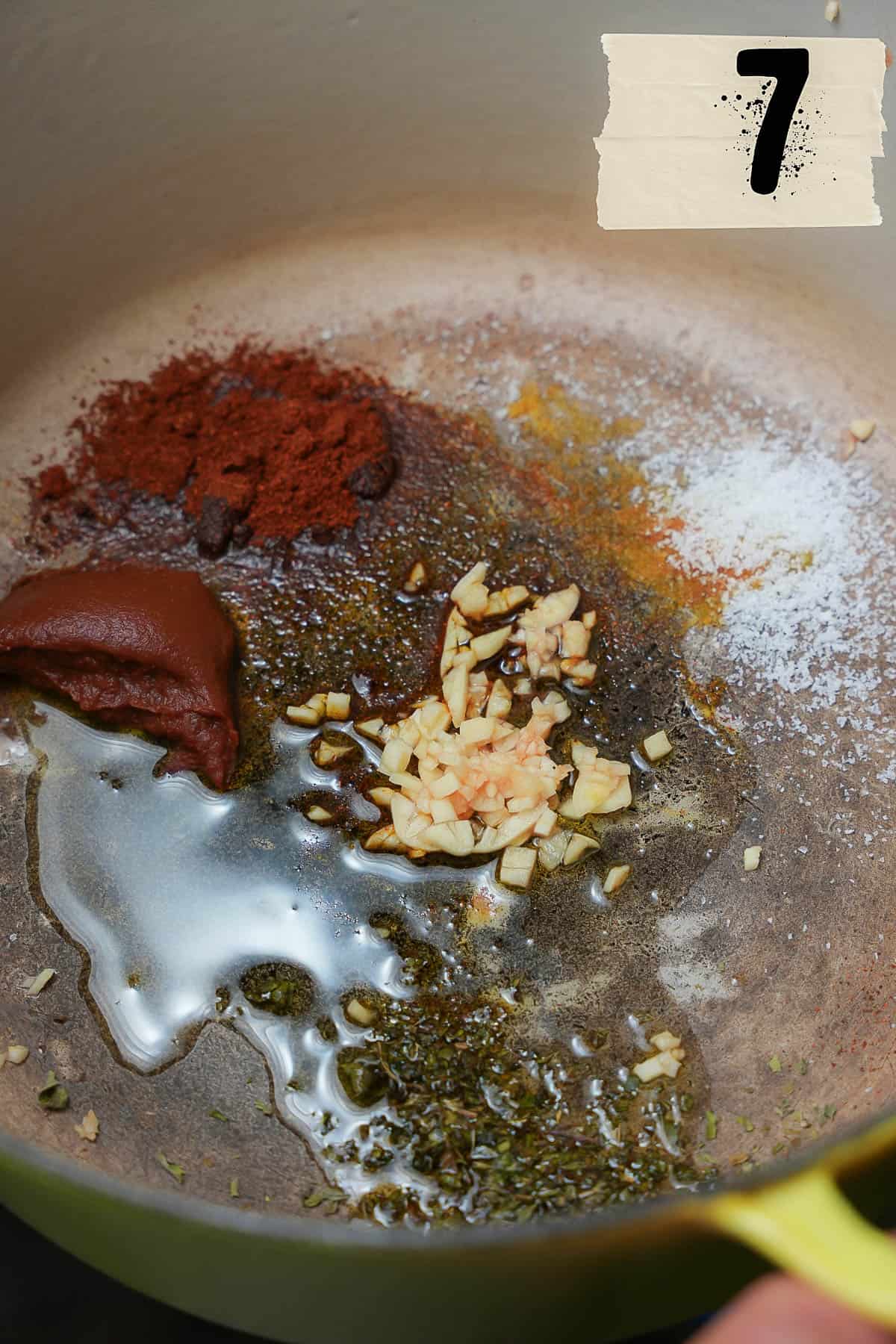
Step 7
In a Dutch oven or thick-bottomed pot, mix together olive oil, tomato paste, paprika, minced garlic, dried mint, and salt. Place a few extra cabbage leaves at the bottom of the pot to prevent burning or sticking. Nestle your stuffed and rolled cabbage into the pot, seam side down.
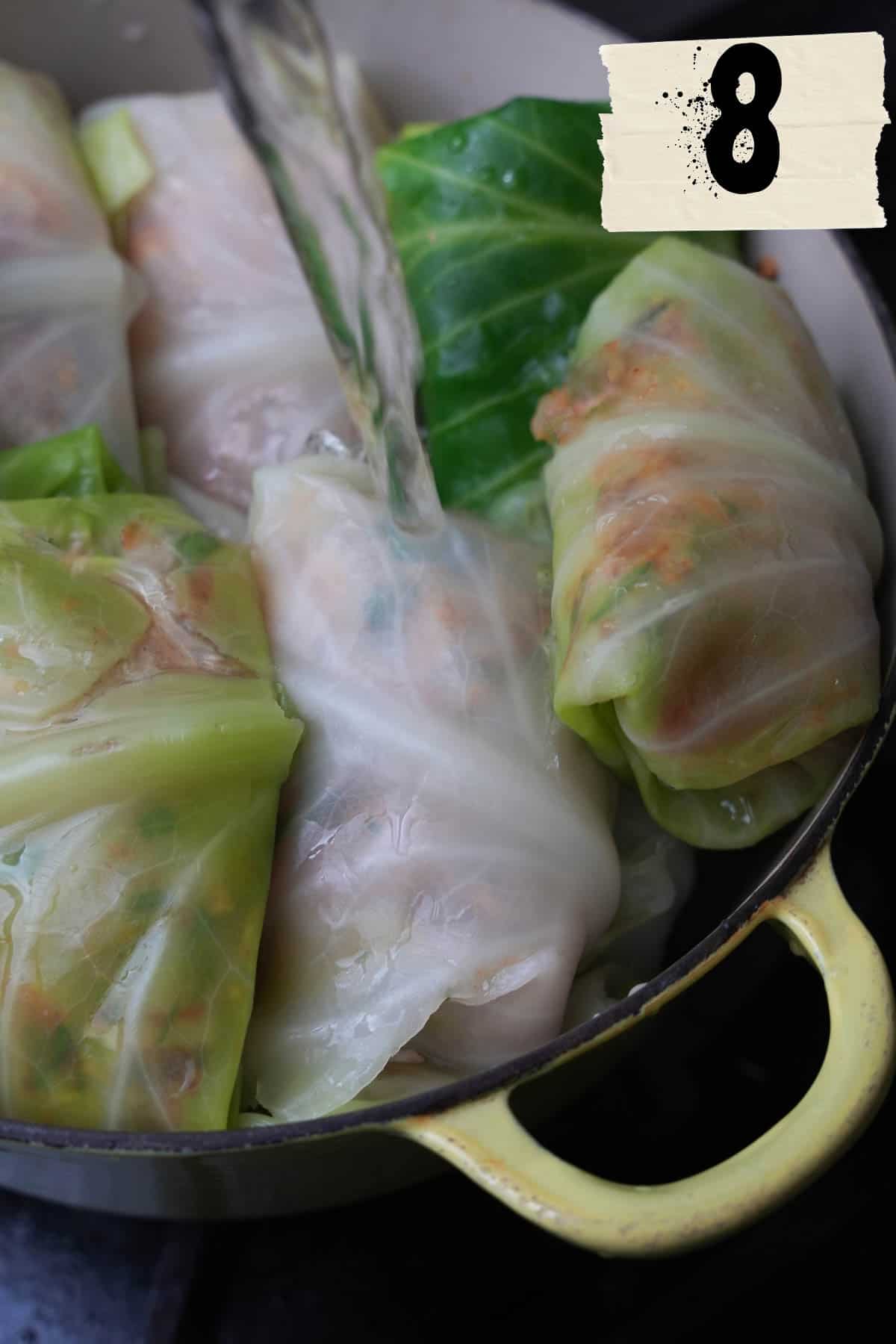
Step 8
Pour boiling water over the cabbage rolls, and place a lid on the pot. Start the pot over medium heat, and after 6 minutes, lower the heat to low, letting the cabbage rolls steam for 40-45 minutes. You’ll know they’re ready by checking one of the rolls, when the rice inside is tender, and most of the cooking liquid has been absorbed.
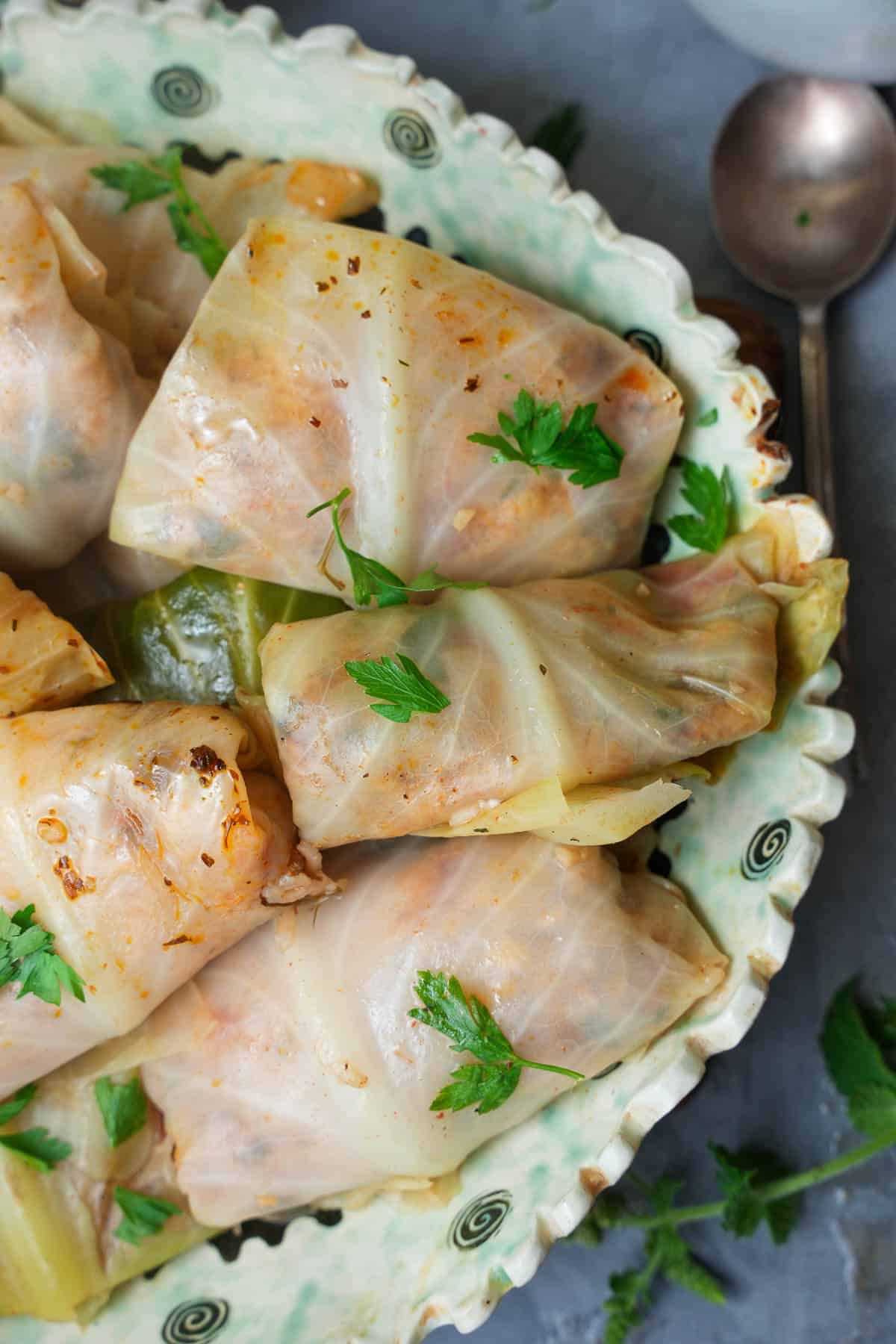
Transfer your beautifully cooked cabbage rolls to a serving dish. Garnish with parsley leaves and a dash of dried mint on top.
Don’t forget to make some dessert! Rosewater Pistachio Baklava or Pine Nut Irmik Helvasi are two classic Turkish dishes that you will not freaking believe.
🍽️Serving Ideas
Don’t let these Turkish stuffed cabbage rolls get lonely! Serve them as part of a Turkish feast!
Pair your rolls with other Turkish appetizers and side dishes like Cif Kofte, or labneh. In winter, they make a great side for Ezogelin (Turkish lentil soup) or Harira.
Serve the cabbage rolls over a steaming plate of Bulgur Pilavi, or eat them with freshly baked Potato Stuffed Flat Bread, or Moroccan Rghaif pancakes.
In the summer, serve them at room temperature with cooling Turkish Yogurt and Mint Soup. Rice and beans make a complete vegetarian protein, so bean dishes like Barbunya Pilaki or Loubia are just the thing.
For a bigger Mediterranean feast, serve them as an appetizer for my Bhaharat Mushroom Shawarma or Vegan Kofta with Tzatziki drizzled with tahini sauce.
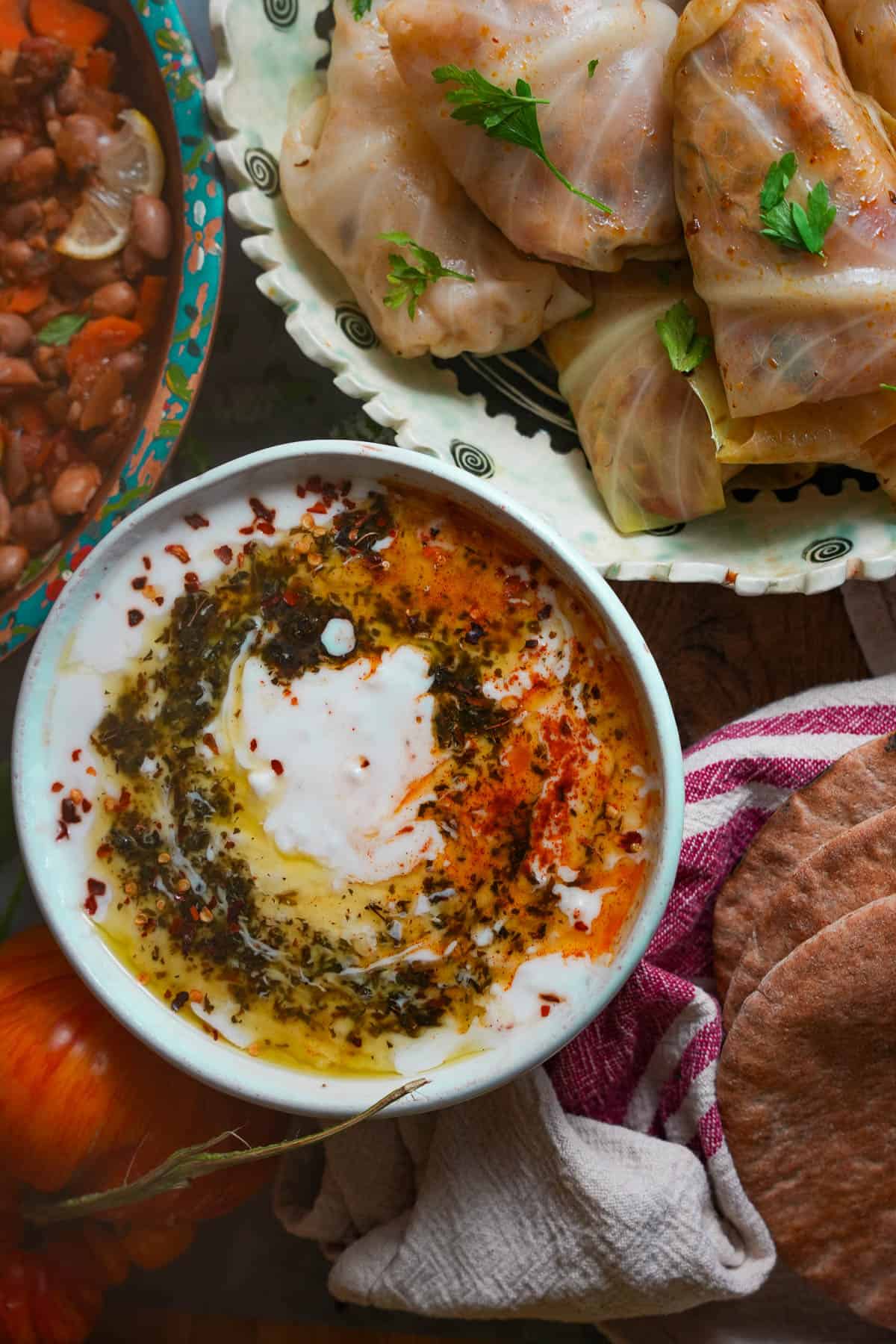
👉Top tip
Blanch with Care: When blanching the cabbage leaves, aim to just soften the leaves for easy rolling without overcooking them. Remember, you're looking for tender, pliable leaves – not overly wilted ones that might fall apart when filled.
Mindful Filling: While adding the filling to the cabbage leaves, strike a balance between generosity and moderation.
Seam-Side Down: When placing the stuffed cabbage leaves in the pot for cooking, always position them seam-side down. This helps keep the rolls intact during simmering and prevents them from unraveling as they cook.
🤷♀️FAQ
"Lahana Sarma" translates to "Cabbage Rolls" in English. It is pronounced as "lah-HAH-nah SAHR-mah."
Yes, you can. While the traditional choice is green cabbage, you can experiment with other cabbage varieties like savoy cabbage, red cabbage or even large collard greens. While savoy cabbage can work if very lightly blanched, Napa cabbage tends to be a little too thin and delicate and tends to fall apart by the time the filling is thoroughly cooked.
Certainly! You can prepare the cabbage rolls ahead of time and store them in the refrigerator for a few days or freeze them for longer storage. Just make sure to reheat them, or at least let them acclimate to room temperature before serving.
To prevent sticking, line the bottom of the pot with torn or small cabbage leaves before arranging the rolls. This creates a protective layer between the rolls and the pot.
To have a ready-to-eat meal on hand long-term, consider freezing your cabbage rolls. Place the stuffed cabbage rolls in a single layer on a baking sheet and pop it in the freezer until they're firm. Once frozen, transfer the rolls to a airtight container. They can be frozen for up to 2-3 months. Make sure to label the container with what they are and the date you made them, in case you forget!
Once your cabbage rolls have cooled to room temperature, transfer any remaining portions to an airtight container. Ensure the rolls are arranged in a single layer to maintain their shape.
✌️See ya later, ‘frigerator
Refrigerate your cabbage rolls for up to four days in a sealed container in your fridge to keep the flavors intact.
🔥 Stovetop Reheating
Place your desired amount of frozen or refrigerated cabbage rolls in a skillet or pot.
Add a splash of water or unsalted vegetable stock to the pan to prevent sticking.
Cover the pan and heat over medium-low heat.
Gently simmer the rolls, occasionally turning them, until heated through. This typically takes about 10 minutes if they were refrigerated, and 17-20 minutes if they were frozen.
☢️ Microwave Reheating
Arrange your cabbage rolls on a microwave-safe plate.
Drizzle a bit of water or unsalted vegetable stock over the rolls to prevent them from drying out.
Cover the plate with a microwave-safe lid or a microwave-safe plate.
Reheat on medium power in 1-2 minute intervals until the rolls are heated to your liking.
✌️Turkish recipes to serve with lahana sarma:

Lahana Sarma (Vegetarian Turkish Cabbage Rolls)
Ingredients
- 1 large green cabbage
- ¼ cup olive oil
- 1 medium onion diced
- 3 cloves garlic minced
- 2 tablespoons tatli biber salcasi or tomato paste
- 1 teaspoon sumac
- 1 ⅓ cup diced tomatoes
- ¼ cup chopped parsley
- 2 tablespoons chopped fresh dill
- 4 teaspoons dried mint
- ½ teaspoons ground black pepper
- 1 teaspoon sweet paprika
- 1 ¼ teaspoons salt
- 2 cups white rice or brown rice
Cooking liquid:
- 1 tablespoon olive oil
- 1 tablespoon tomato paste
- 1 teaspoon paprika
- 1 clove garlic minced
- 2 teaspoons dried mint
- ½ teaspoon salt
- 2 ¾ cups hot water
Garnish:
- Parsley leaves
- Dried mint
Instructions
- Begin by carefully separating the cabbage leaves from the head. Blanch the leaves in boiling water for a few minutes until softened. Remove and set aside to cool.
- In a deep skillet or dutch oven, heat the olive oil over medium heat. Add the diced onion and sauté for 4-5 minutes until translucent, then stir in the minced garlic.
- After about a minute, stir in the tatli biber salcasi (or tomato paste) and sumac into the sautéed onions and garlic. Stir to combine and let the flavors deepen as the onions and garlic continue to cook for a couple of minutes.
- Add the contents of the pan to a mixing bowl along with the diced tomatoes, chopped parsley, fresh dill, dried mint, black pepper, sweet paprika, salt and uncooked rice.
- Lay a blanched cabbage leaf flat, rib side facing out, and place a spoonful of the filling in the center. Roll the leaf, tucking in the sides as you go, creating a snug parcel. Depending on the size of the leaf, and the size of stuffed cabbage you prefer, you should put 2-4 tablespoons of filling into each one. Repeat with the remaining leaves and filling. Any torn or small leaves should be saved to line the bottom of the pan with.
- In a dutch oven or thick-bottomed pot, prepare the cooking liquid by whisking together olive oil, tomato paste, paprika, minced garlic, dried mint, and salt. Carefully arrange the cabbage rolls in the pot, seam side down, laying any extra leaves at the bottom of the pot to prevent sticking or burning.
- Gently pour hot water over the rolls until they are mostly submerged. You can place a heatproof plate on top to keep the rolls in place if needed.
- Bring the liquid to a simmer over medium heat. Cover the pot, turn the heat down to low and let the cabbage rolls cook for about 40 minutes, until the rice inside the rolls is tender, and most of the cooking liquid has been absorbed.
- Once cooked, transfer the cabbage rolls to a serving dish. Garnish with parsley leaves and a sprinkle of dried mint.

Enter your email & I'll send it to your inbox. Plus, get great new recipes from me every week!
By submitting this form, you consent to receive emails from Cinnamon Snail.

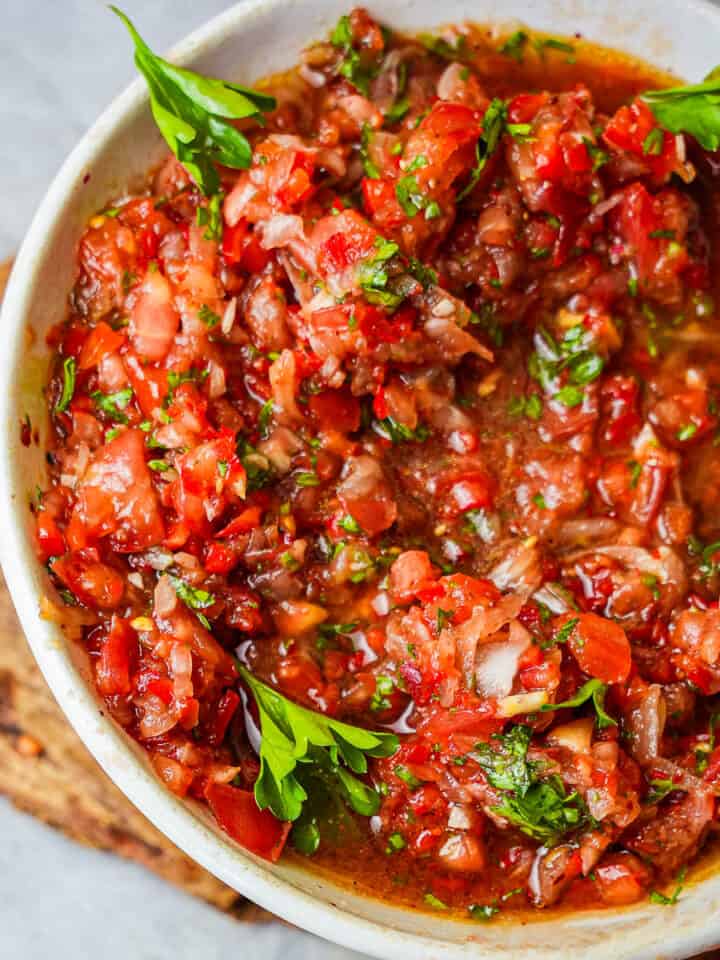

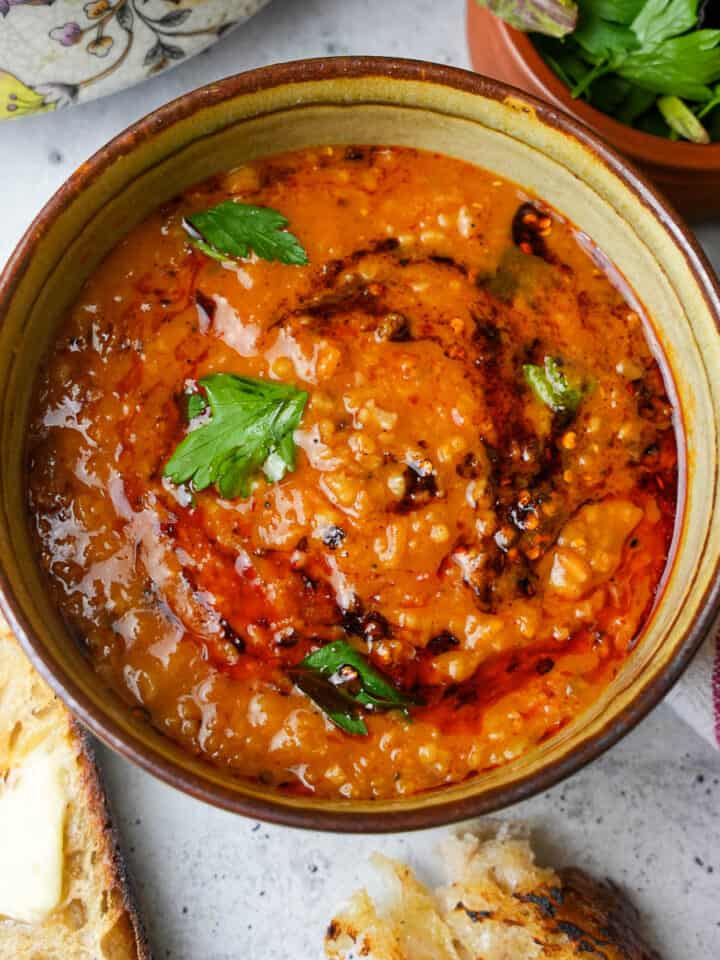
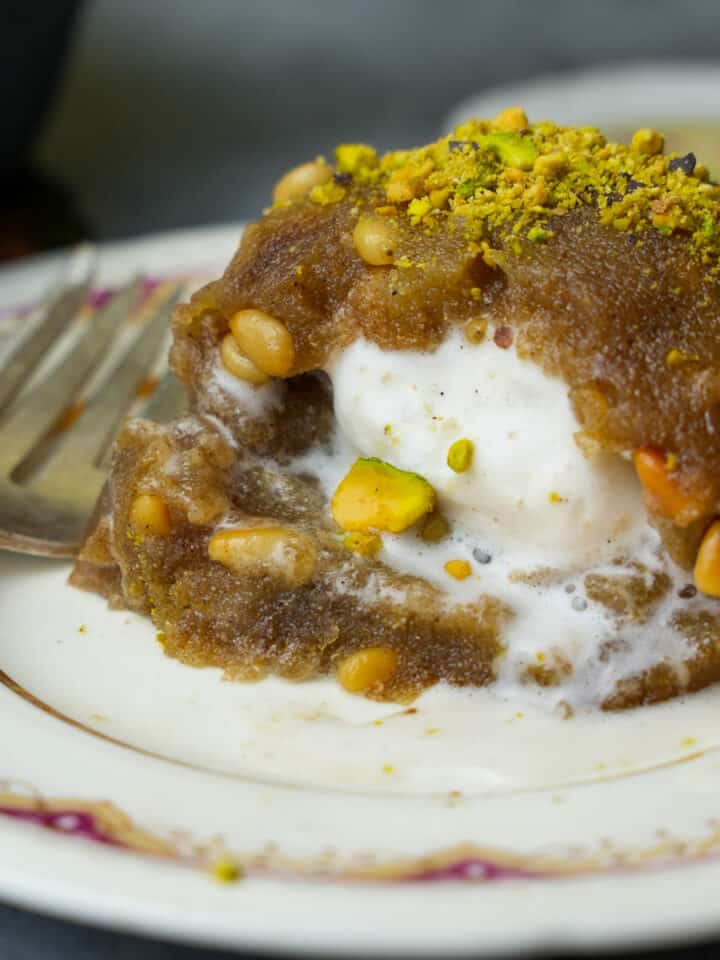






Leave a Reply